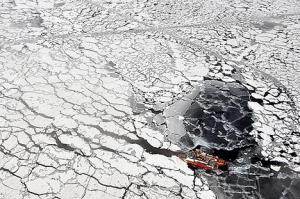Coastal resilienceA melting Arctic demands more – not less – research on earth science
The Arctic is melting rapidly. Who cares? Anyone who is concerned about the rising price of food, lives near the coast, shoveled snow all winter, can’t water their lawn anymore, pays a bigger premium now for property insurance, or enjoys eating seafood. Did we leave anyone out? Apparently so, yet this group of people should care as much as anyone. The House of Representatives earlier this year slashed NASA’s earth sciences research budget, which funds much of the research U.S. scientists do on the Arctic. Scientific research is not a luxury to be indulged. It is an essential contributor to our national well-being, helping us avoid costly mistakes while finding new ways to improve our security, our economy, and our quality of life. Today, Congress is taking us on a course toward an Arctic legacy of myopia, feebleness, and ignorance. Rather than denying the changes that affect us all, they should be steering our national policies toward scientific excellence and vigorous action on challenges such as Arctic meltdown and its impacts. Nowhere is the evidence clearer; never has the need for research been more urgent. We ignore the Arctic at our peril.

Canadian and U.S. Coast Guard vessels in tandem // Source: commons.wikimedia.com
The Arctic is melting rapidly. Who cares? Anyone who is concerned about the rising price of food, lives near the coast, shoveled snow all winter, can’t water their lawn anymore, pays a bigger premium now for property insurance or enjoys eating seafood. Did we leave anyone out? Apparently so, yet this group of people should care as much as anyone. The House of Representatives earlier this year passed a budget that funds NASA’s earth sciences research at US$1.45 billion— down 18 percent from $1.77 billionin fiscal year 2015 and well below (26 percent) the White House request of $1.95 billionin 2016. NASA’s earth sciences work and the National Science Foundation’s geosciences budget fund much of the research U.S. scientists do on the Arctic.
These programs provide data that will help pin down the scope of the many impacts from a changing Arctic and help decision-makers in communities across the country prepare for them.
Most Americans are aware that Arctic ice is disappearing, but few appreciate the enormity of its effects on their daily lives. And as time goes on, effects from the changing Arctic will increasingly be in our headlines.
Wrong direction
Back in the 1850s, the Arctic was in the news when the Royal Navy searched for Sir John Franklin’s missing Northwest Passage expedition, a failed attempt to plot a path from the Atlantic to the Pacific through the Arctic Ocean.
Today, Arctic navigation is a hot topic again as sea ice disappears, raising new opportunities and challenges. In addition to satisfying our longstanding fascination with all things Arctic, today’s interest is – or should be – also highly practical.
California’s ongoing drought and the East Coast’s snow-filled winter of 2014-15 are in part the result of changing weather patternsdriven by the Arctic meltdown. New studies suggestthat strong, persistent northward swings in the jet stream — like the one that has been sitting off the west coast of North America almost continuously since late 2013 and is responsible for drought and the intense wildfire season in the western US – are initiated by ocean temperature patterns that are intensified by the disproportionately warm Arctic. A similar condition exists in Eurasia, where sea-ice loss north of western Russia contributes to heat waves in Europe and colder winters in central Asia.
